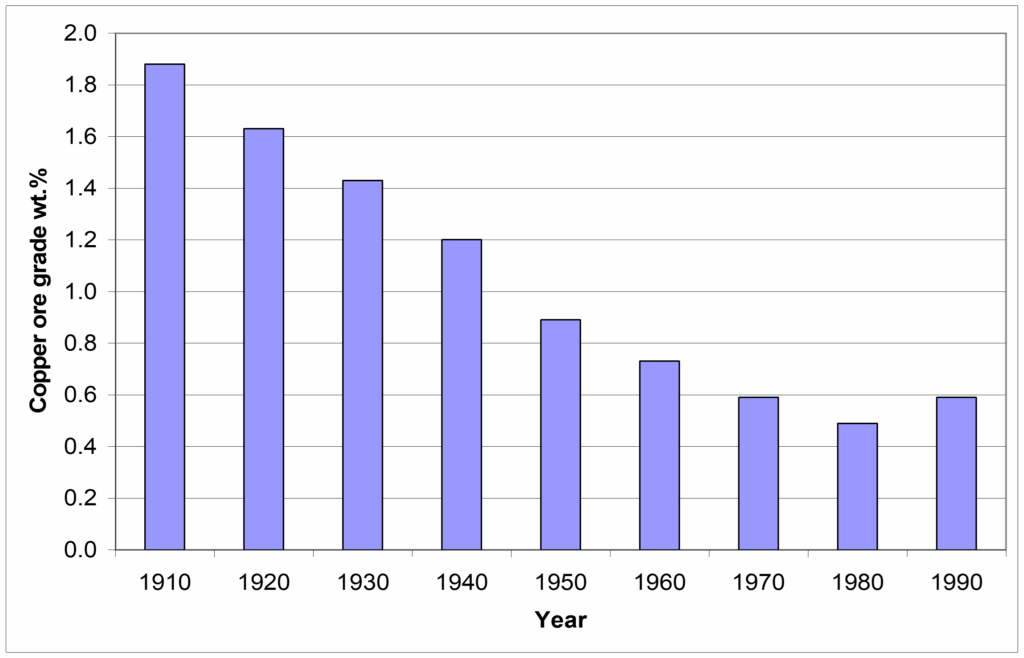Ore Grades and Reserves
Ore bodies are not homogeneous. Their composition and mineralogy may vary with extent and depth. Hence careful ore sampling and mineralogical characterization is essential. This affects both economics (how much ore and metals of interest there are) and extraction processing. For instance, nickel laterite ores (weathered near-surface sulfides) contain an upper limonite zone which can be treated hydrometallurgically using H2SO4 at high temperatures ands pressures, and a lower serpentine zone. The latter is high in acid-soluble silicates and makes hydrometallurgical acid leaching uneconomic.
Over the years as richer ores have been exploited first, ore grades have decreased for many metals in the developed countries. This is illustrated for the case of copper in Figure 8. As ore grades decrease, technological developments and research have been needed to continue to meet demand. Hence, in many cases the grade of ore that can be economically mined has decreased significantly. Estimates of the minimum grade for economic recovery and world reserves are listed in Table 5. There is considerable variation in the estimates of what constitutes an economic ore grade. Note that the estimated world reserves for some metals are quite small. While ores have become leaner and more complex, standards for metal purity have, in some cases, become more exacting.
Proven or known reserves are resources that companies have rights to, but which are as yet undeveloped. These may be part of an operating project, or may not yet have been exploited at all. Resource companies plan roughly 10-15 years into the future. It is neither needful nor helpful to tie up money in looking for resources that might be of interest many decades later. This can sometimes lead to an overly pessimistic view of available world resources, especially when production rates are compared to total proven resources. Then it looks like we will run out of everything in a decade or two. Oil is a good example. Based on then known reserves and production rates in the 1970’s it looked like oil would run out around the turn of the millennium. Nevertheless, it looks like we are now depleting the available supply of some natural resources.
Required purities of refined metals are summarized in Table 6. High purity is the order of the day. Properties of very pure metals often differ significantly from those of slightly less pure metals (e.g. conductivity of copper is strongly affected by low levels of arsenic). It is remarkable that high throughput, continuous chemical processes are able to produce very pure metals from often very low grade starting materials. There are international specifications for metals and compounds (e.g. LME – London Metals Exchange), national specifications and specifications set by specific customers. All standards have in common a specified content of the metal or compound and/or specified levels of impurities.

| Table 5 - Estimated ore grades and world reserves for some metals. | |||
|---|---|---|---|
| Metal | Natural abundance wt. % (lithosphere) |
Ore grade, wt.% | World reserves, tonnes |
| Al | 8.2 | 27-60 | immense |
| Cr | 0.31 | 27-34 1 | 6.8 X 109 |
| Co | 0.003 | 8.3 X 106 | |
| Cu | 0.0068 | 0.5-2 | 5.7 X 108 |
| Au | 3.1 X 10-7 | 0.0001-0.001 | 4.9 x 104 |
| Fe | 6.3 | 30-60 | 2.3 x 1011 |
| Pb | 0.0013 | Feb-15 | 1.2 x 108 |
| Mn | 0.11 | 45-55 | 3.5 x 109 |
| Mo | 0.00011 | 1.3 X 107 | |
| Ni | 0.09 | 0.5-9 | 1.1 x 108 |
| Pt | 3.7X10-6 | 0.001 | 1 x 105 |
| PGM 2 | 4 X 10-8 - 6.3 X 10-4 | 1 X 108 | |
| Ag | 8X10-6 | 0.003-0.08 | 4.2 x 105 |
| Sn | 0.00022 | 01-May | 6.1 x 106 |
| Ti | 0.66 | 2.5-25 | |
| U | 0.00018 | 0.01-25 | |
| V | 0.019 | 1.6-4.5 | 1.6 x 107 |
| Zn | 0.0079 | Mar-30 | 3.0 x 108 |
| 1 As chromite ore. 2 Platinum group metals together: Ru, Os, Rh, Ir, Pd and Pt. |
|||
| Data Source: Kirk-Othmer encyclopedia of chemical technology (4th ed.). (1995). John Wiley & Sons. | |||
| Table 8 - Relative energy requirements for production of metals from ores versus production from scrap. |
|||
|---|---|---|---|
| Metal | Primary (from ore) Energy, GJ/tonne metal |
Secondary (from scrap) | Energy Savings |
| Magnesium | 372 | 10 | 362 |
| Aluminum | 253 | 13 | 240 |
| Nickel | 150 | 16 | 134 |
| Copper | 116 | 19 | 97 |
| Zinc | 68 | 19 | 49 |
| Steel | 33 | 14 | 19 |
| Lead | 28 | 10 | 18 |
| Data Source: Hayes, P. C. (1985). Process selection in extractive metallurgy. The Australasian Institute of Mining and Metallurgy. | |||
Media Attributions
- Average copper ore grade mined © Kirk-Othmer Encyclopedia of Chemical Technology is licensed under a CC BY-NC (Attribution NonCommercial) license

